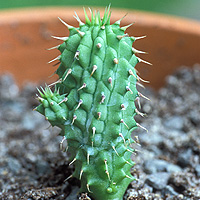Hoodia
Uses
Parts Used & Where Grown
Hoodia is a succulent plant that looks like a cactus. A member of the milkweed family, hoodia is native to the Kalahari desert in the southern tip of Africa, principally in the nations of South Africa and Namibia. The plant's latex and inner parts are used, with the spines removed.
Our proprietary “Star-Rating” system was developed to help you easily understand the amount of scientific support behind each supplement in relation to a specific health condition. While there is no way to predict whether a vitamin, mineral, or herb will successfully treat or prevent associated health conditions, our unique ratings tell you how well these supplements are understood by the medical community, and whether studies have found them to be effective for other people.
For over a decade, our team has combed through thousands of research articles published in reputable journals. To help you make educated decisions, and to better understand controversial or confusing supplements, our medical experts have digested the science into these three easy-to-follow ratings. We hope this provides you with a helpful resource to make informed decisions towards your health and well-being.
3 Stars Reliable and relatively consistent scientific data showing a substantial health benefit.
2 Stars Contradictory, insufficient, or preliminary studies suggesting a health benefit or minimal health benefit.
1 Star For an herb, supported by traditional use but minimal or no scientific evidence. For a supplement, little scientific support.
This supplement has been used in connection with the following health conditions:
| Used for | Why |
|---|---|
|
1 Star
Obesity
Unknown
|
Some clinical trials suggest hoodia may be effective at curbing appetite.
Hoodia gordonii is a succulent plant that grows in the desert in southern Africa. One small clinical trial found that hoodia latex and inner plant significantly reduced food intake. However, in a placebo-controlled trial, 1.11 grams of hoodia extract taken twice a day for 15 days had no effect on caloric intake or body weight compared with a placebo. Adverse effects of hoodia included nausea, vomiting, and increases in blood pressure and bilirubin levels (a possible indicator of liver stress). Another placebo-controlled trial found 3 grams of a frozen hoodia product taken daily for 40 days led to reduced hunger, food cravings, and self-reported food consumption, accompanied by weight loss; only mild, short-term adverse side effects were reported. More research is needed to determine if hoodia has a potential role in treating obesity.
|
Traditional Use (May Not Be Supported by Scientific Studies)
The San people, native to the Kalahari desert, have used hoodia for millennia to suppress appetite for food and water and to increase energy.1 They cut the spines off the plant and eat the inner portion and drink the white latex.
How It Works
How It Works
A South African government agency, the Council for Scientific and Industrial Research (CSIR), found that a compound found only in hoodia’s latex and inner flesh, steroidal glycoside (called P57), was able to suppress appetite in animals. This effect was clearly related to effects in the brain as opposed to the stomach.2 One small clinical study has been completed by Phytopharm, a company that bought the exclusive licenses to develop and market P57 from CSIR. This study involved 19 overweight men using P57 and found that P57 did reduce their food intake significantly compared with a placebo. The details of this study have not yet been published in any medical journal, so its conclusions cannot yet be evaluated for accuracy.
How to Use It
There is no clear information on how much hoodia is necessary to reduce appetite. Anecdotal reports suggest that 2 ounces (60 grams) or more per day of the crude plant may be necessary.
Hoodia is a slow-growing plant that thrives in a relatively limited geographical area. Given the potential for becoming endangered due to high demand, there are strong regulations in place (based on the international treaty called the Convention on International Trade in Endangered Species) blocking its export. It is presently unclear if any supplements available in the US reliably contain Hoodia gordonii and how much would have to be taken of them to be useful. The Phytopharm company says they have a plantation to sustainably grow hoodia for the product they intend to release someday, but this product is not yet available.
Interactions
Interactions with Supplements, Foods, & Other Compounds
Interactions with Medicines
Side Effects
Side Effects
References
1. Thompson G. Bushmen squeeze money from a humble cactus. New York Times 2003 Apr 1;Sect. A:4 (col 3).
2. MacLean DB, Luo LG. Increased ATP content/production in the hypothalamus may be a signal for energy-sensing of satiety: Studies of the anorectic mechanism of a plant steroidal glycoside. Brain Res 2004;1020:1-11.
Last Review: 06-01-2015

Copyright © 2025 TraceGains, Inc. All rights reserved.
Learn more about TraceGains, the company.
The information presented by TraceGains is for informational purposes only. It is based on scientific studies (human, animal, or in vitro), clinical experience, or traditional usage as cited in each article. The results reported may not necessarily occur in all individuals. For many of the conditions discussed, treatment with prescription or over the counter medication is also available. Consult your doctor, practitioner, and/or pharmacist for any health problem and before using any supplements or before making any changes in prescribed medications. Information expires December 2025.



